Newton School of Metalworkers
The existence of the Newton School of Metalwork is well documented, primarily thanks to the exhibits in the annual Home Arts and Industries Exhibitions in the late 1890’s and the link with the former Guild of Handicraft member, John Williams. However, there is very little written about the School, the people involved, and the work it produced. I suspect much of the local knowledge is gradually being forgotten and so when I found a pair of chambersticks by one of the Schools key workers, Albert Prime, I decided to do some more detailed research.
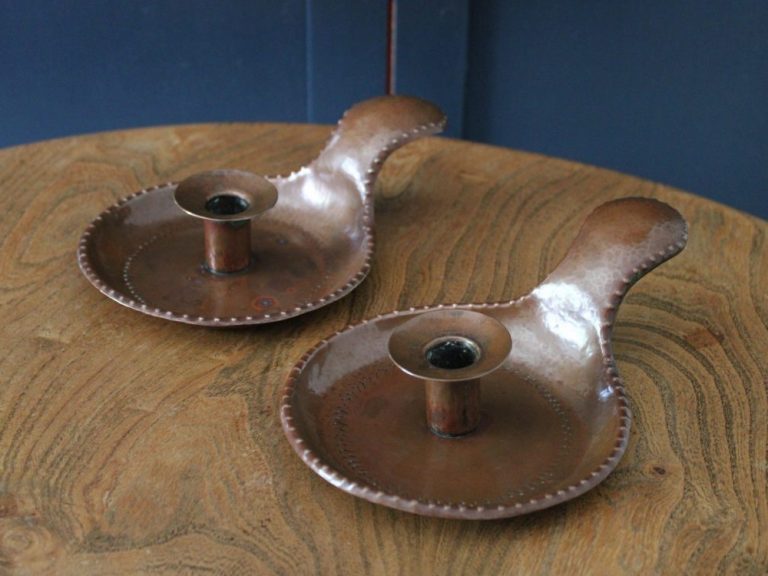
Copper chambersticks made by A. Prime at the Newton School of Metalwork, Cambs
Much of this information is built around a short write up on the School kindly shared with me by current residents of Newton. The information is believed to come from the village School Mistress, Miss Cranfield, in 1935.
Newton is a civil parish and small village in Cambridgeshire. Situated around 7 miles to the south west of Cambridge, it lies on the old coaching road between London and Cambridge. It’s population today is somewhere between 300 and 400 people but in 1890 it would likely have been under 200 people. It was a farming community and most people who lived in the village were agricultural workers.
The story probably starts with William Hurrell of Newton Manor sometime in the mid to late 1800s. William Hurrell was a wealthy landowner and farmer and was no doubt an important figure in the village. He would have employed a significant proportion of the men in the village. William started an evening class for the men and lads in the village. The class was held in the Old Vicarage coach house and stables during the winter months; the subjects taught were reading, writing, arithmetic and a little singing, which was accompanied by one of the local men who played a concertina1.
A move towards handicrafts came through William’s son, Harold William Hurrell. In 1890, he had just finished his education at Eton and Trinity Hall, Cambridge. It seems likely that he was aware of the Arts and Crafts movement and possibly even the Home Arts and Industries Association which, by 1890, held an annual exhibition at the Royal Albert Hall in London. He was interested enough to attend an Arts and Crafts School in London1. Unfortunately I’m unable to say for sure which school this was but it is possible that it was the Guild and School of Handicraft set up in London by C. R. Ashbee in 1888. This may well have been where the later link with John Williams of the Guild of Handicraft began.
Harold was an enthusiast and taught many handicrafts including picture framing with brown paper, mosaic tile work, basket making, wood carving, clay modelling and Venetian Ironwork1.
Another key figure in the formation of the school is Miss Nash. Unfortunately Miss Nash’s full name is never used in any of the references found to date. Miss Nash, also of Newton, learnt brass and copper repousse work in London and later passed on her knowledge as a teacher in the School1.
The elusive “Miss Nash” is actually Ann Eliza Nash who resided on Town Street (Old census records as Church Street), and is described as “living on own means”2. It was very fashionable at this time for well to do ladies to become involved in philanthropic ventures.

Members of the Newton School of Metalworking, Cambridgeshire. Albert Prime is second from the left on the back row
Metalwork at the School started around 18903. The first reports of the Schools work appear in December of 1891, at the Industrial Loan and Exhibition in Royston.
“Among articles not for competition, special mention should be made of the interesting collections of artistic handiwork sent in from the Newton Evening School under the direction of Mr. Hurrell and Miss Nash. From the Newton School 64 articles were exhibited. Principal exhibits were in Venetian ironwork, repousse work in brass and copper many of the articles being pretty in design and of reasonable price.4”
In the Newton class the judges awarded a first degree of merit to Willie Moore for copper repousse work; 2nd to _____ Drury, for brass repousse. Sidney Andrews, of Newton, School, was also highly commended for mosaic.
In 1893 the school was part of a bazaar held in Cambridge Arcade and further items in Venetian ironwork metal repousse were exhibited. We also learned more about the class at Newton, still under the management of both Harold Hurrell and Miss Nash.
“The lads are provided with tools and materials, and after their work is done, the articles are sold, and all profit, after paying for materials, is divided amongst them. The articles were in many cases remarkably handsome, and the prices were unusually low. Stalls were presided over by Miss Nash and Mr Harold. W. Hurrell. The movement is one that could well be copied in other villages, but a different kind of work should be taught or the market will be overcrowded.5”
In 1894 the work of the Newton School was mentioned in the important Arts and Crafts periodical, The Studio. The article covered the Home Arts and Industries Exhibition held at the Royal Albert hall in London. The article states that some repousse work, in which the admirable influence of Essex House was apparent, came from Newton, near Cambridge6. The reference to Essex House again makes a strong link with the Guild of Handicraft School which,by 1894, was based in Essex House in London.
By 1895 the school was becoming noticed for the quality for the quality of it’s work. At the Cambridge Exhibition of Work by Technical Education Students, the Newton class topped the awards table with 13 certificates and 8 prizes in Iron work and repousse metalwork.
It’s clear that quite a number of men from Newton were becoming very skilled. Twelve men are named in the awards section – C. Moore, Seth Andrews, G. Hunt, E. Andrews, J Andrews, Evan Fuller, G. Dixon, H Drury, W Pink, J Sharphall, F Moore and P Rogers. Prizes were awarded for a fender, a bracket for three candles and a mirror.
“Active work was shown by Newton in repousse; by Newton and Shelford in bent iron. The most interesting stall was that of Newton upon which specimens of repousse work and also a little bent iron-work. The work was begun in Newton before the grant from the Exchequer, and much success has been achieved. Many of the exhibits were choice in design and excellent in workmanship, and the rapid sale of them showed the appreciation of the public7”.

Copper door lock plate made by A. Prime at the Newton School of Metalwork, Cambs. Looking very much like a copy of a Birmingham Guild of Handicraft piece.

Brass door lock plate made by A. Prime at the Newton School of Metalwork, Cambs
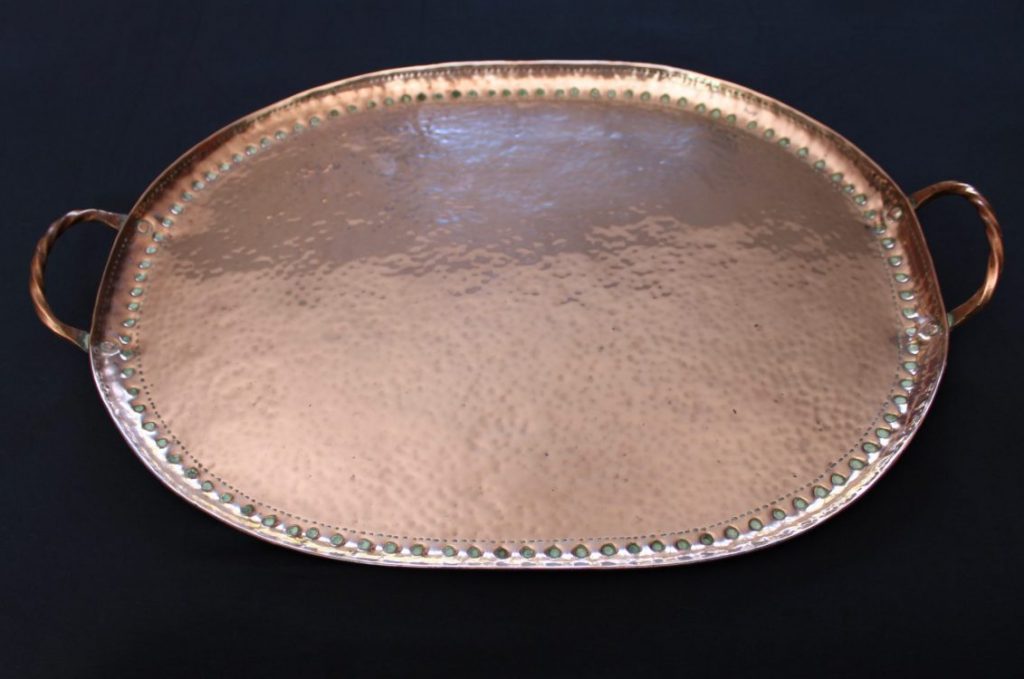
Copper tray made by A. Prime in 1924. A tray of this design is also pictured above in the image of the workers from the school
A major success for the school was the patronage of Prince of Wales. In 1895 the class was commissioned to make two large panels for the Prince6.
At the 1896 Cambridge Exhibition of Technical Work the Newton School was praised for “a magnificent lot of metalwork, Venetian bent ironwork, repousse work etc in various artistic designs8”.
We also get our first mention of Albert Prime who won first prize in the Ironwork section. Other prizes were awarded in the repousse metalwork section to George Hunt, Sidney Andrews, Esau Fuller and George Kemp.
Success continued in 1897 and more and more workers names appear in the prize list at the exhibition of Cambridge Technical Work in the County along with a short description of the school, “The inhabitants of the small village of Newton, a place having a population of about 200, have evidently spent a highly profitable winter, and the social advantages accruing from the work, to say nothing of the mental, could not but have been vividly presented to the mind of every thinking observer. For the past six or seven years Newton has been a hive of industry in the metalworking line, and this year they managed to send up 170 exhibits in this section. These were done either in copper or brass. We were particularly attracted with the copper articles; they displayed good diversity of designs, and were exceedingly well worked, the effect being rich and artistic. The rose water dishes were handsome specimens of work and so were the fine large mantel panels and over mantels executed by George Hunt, a labourer 21 years of age. A novelty in the brass work were the one shilling Diamond jubilee trays. Through their proficiency in the in this character of industry the people of Newton have opened up a new mode of support, and they can now find a ready market for the goods in the Metropolis and other parts of the Kingdom. Some of the things, such as the candelabras, with worked, copper, wall ornament, had a certain amount of wrought iron in their constitution, and this year, unlike preceding years, the whole of the wrought iron employed in the making of the different exhibits had been worked up in a school forge in the village9”.
In the metalwork section the following workers are mentioned – George Hunt, George Kemp, Sidney Andrews, A Prime, F. Moore, Stanley Rogers, Harvey Rogers, T. Newling, Percy Rogers, Elijah Fuller and John Fuller.
The Newton School also appeared again the The Studio write up of the Home Arts and Industries Exhibition in London. A pierced fender with design of ships in a setting sun from Newton was deemed worthy of special note. The fender was designed by former Guild of Handicraft member, John Williams. Further in the same article we are told that “Mr J. Williams, from whom (especially in the Newton and Cambridge groups) came much of the best schemes in wrought metal throughout the gallery10”.
John Williams was one of the two original metalworkers with the Guild of Handicraft when it founded. He taught metalworking classes as well as clay modeling, wood carving and plaster casting. He left the Guild in 1892 and was involved with a number of the schools linked with the Home Arts and Industries Association including the Newton School and the Fivemiletown class in Ireland. Subsequent research has shown that John Williams, Mary Williams and George Tanner all designed pieces for the school and a separate article provides more details here.

Copper fender illustrated in The Studio in 1897
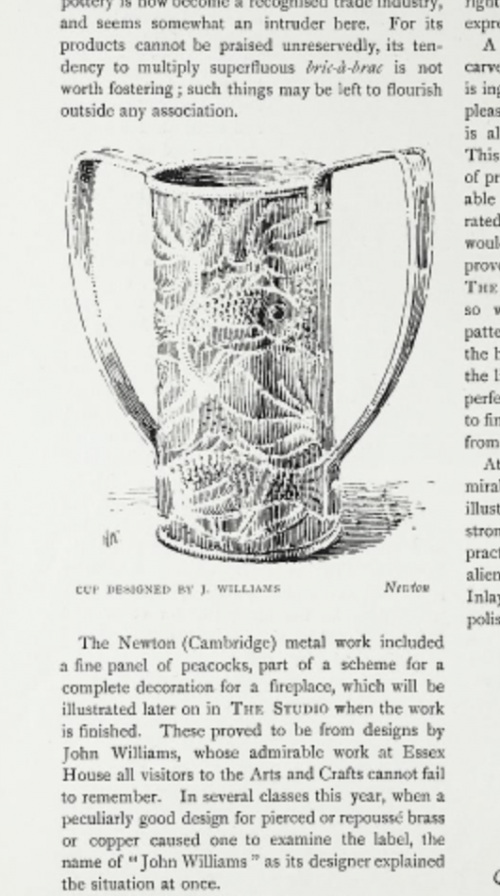
A cup designed by John Williams and made by the Newton School was shown at the Home Arts and Industries Association exhibition in 1898 and illustrated by The Studio (11).

A cup designed by John Williams and likely made by the Newton School.
The 1898 Technical Exhibition at Cambridge discussed the commercial success the school was now achieving. It also talks about the student learning to draw and clay modelling. The school was also by now making ecclesiastical metalwork and a pair of candlesticks had been designed and made for the nearby Waterbeach Church.
“In some cases the workers in country districts were able to supplement their income as a result of the skill and training acquired in these classes. The Newton students afford a striking instance of this. The classes have had the advantage and energy of Mr Hurrell and Miss Nash, and the excellence of their work is a feature at these exhibitions. The skilled handicraft in brass and copper and the forged iron-work from Newton is very noticeable. The fact that Dr Waldstein, one of the judges, said that Newton had surpassed itself was a great compliment to the workers. Among the exhibits was a fine pair of huge candlesticks, which were made to a special design for Waterbeach Church. The work at Newton is almost developed into an Industry and another proof of it’s excellence is that fact that it finds a ready sale in the market, and appeals to the artistic taste of the Parisians, whilst the Prince of Wales has patronized the work for some time past. Some of the goods are shown in the Home Arts and Industries Exhibition each year, and this enterprise might well be copied by other villages. The students at Newton in addition to learning drawing, which is part of the system, now have regular teaching in clay modeling, which is a great assistance to them, and some specimens of this were shown12”
1898 is the last time Miss Nash is mentioned. It seems that her involvement with the school ended around this time. Her importance to the school is well illustrated by the incredible cross, made in her memory upon her death in 1906.
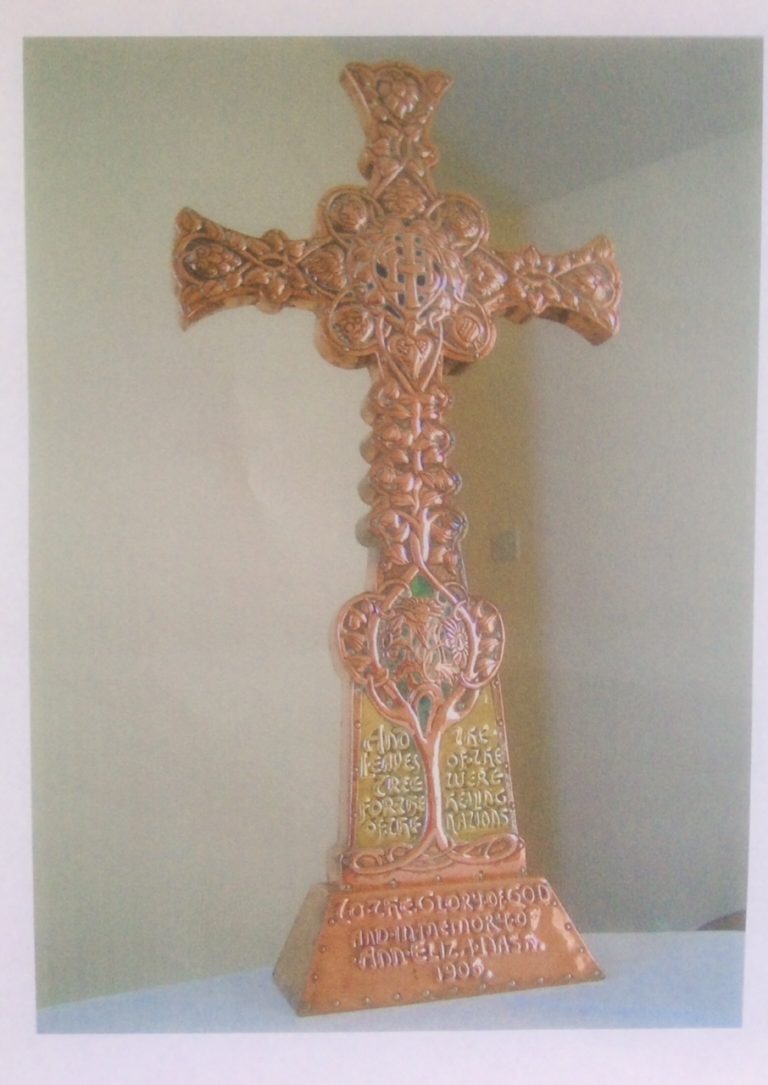
A memorial cross to Ann Eliza Nash. Made by the Newton School, circa 1906.
Further brass and copper repousse work was exhibited at the Exhibition of Work at the Guildhall, Cambridge, in 1899. Workers awarded prizes included G. Kemp, S. Andrews, J. Fuller, R. Rogers, J. Merton, C. ink, A. Todd, J. Fuller, R. Rogers, J. Merton, C. Andrews and George Hunt13.
Around this time the School appears to have started making ornamental clock faces along with more ecclesiastical examples of work.
“The repousse metalwork was as usual a great feature. Newton occupies a prominent place. The workers there continue to send many of their articles all of which bear the mark of skilled workmanship, to outside markets, no less than £80 worth has been sold this season. A striking feature were some ornamental clock faces in copper and brass and a handsome font ewer having been brought from Waterbeach church as a specimen of Newton artistic handicraft.14”
Clocks were mentioned again in the opening speech by Viscount Peel at the Techical Education exhibition at the Guildhall in Cambridge, 1900.
“There was a village in this county, five or six miles from Cambridge, called Newton where there was a population of 150 people. He saw some clocks before him which he believed came from Newton. The inhabitants were a purely agricultural people, but they had been induced, chiefly through the energy of one individual to take up the subjects of iron work and copper work, with the result that at the end of the year they had produced – not in substitution of their ordinary work, for that would be a mistake, but in addition, and supplementary to their ordinary work – £150 worth of goods, and when the balance was struck, and the expense of the material and other expenses deducted was returned to the inhabitants of that village as the product of their supplementary labour. If Newton could do this he supposed other villages could do it too. He hoped all villages would not rush into the clock making or repousse copper work, but surely among the manifold industries which occupied Englishmen there was a variety of labour for each village without one clashing with another.15”
The clocks were described as having old fashioned dutch dials with pretty patterns and bearing apt quotations. Another piece by the school that received great praise was an iron and metalwork sign made for The Green Man tavern in Grantchester by Messrs Starr and Prime. Prize winners included Ernest Andrews, Albert Todd, Chas Andrews, Chas Pink, John Fuller, Jas. Merton, Elijah Fuller, Fred Starr and Albert Prime15,16.
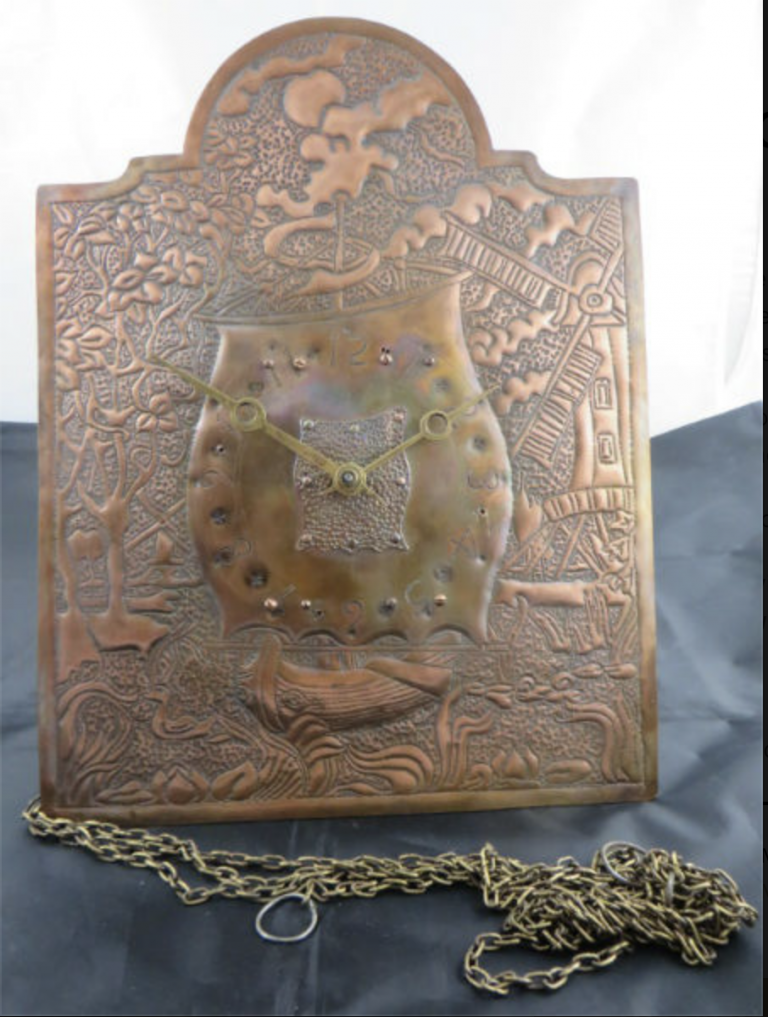
A clock made by the Newton School, circa 1900. Image used courtesy of artsandcraftsantiques.co.uk
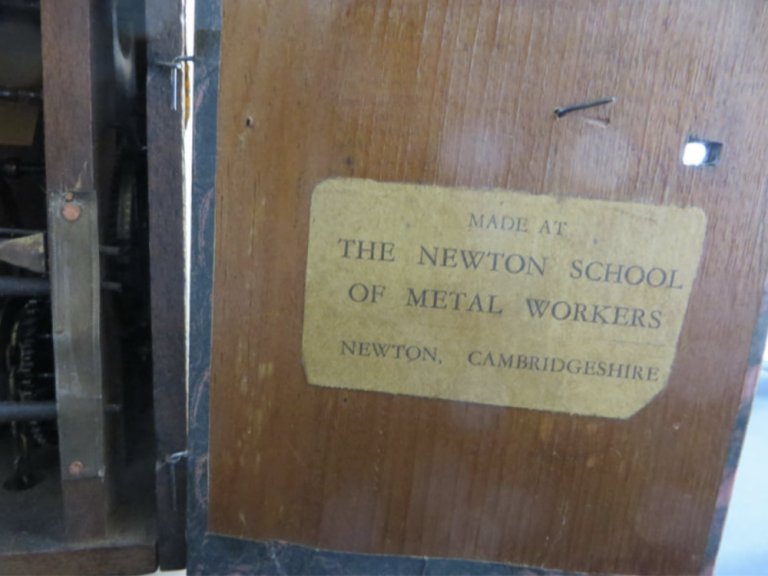
A clock made by the Newton School, circa 1900. Image used courtesy of artsandcraftsantiques.co.uk
In 1901 the School exhibited again at the Technical Education exhibition in Cambridge. Clocks again appeared to feature heavily. Prize winners were Ernest Andrews, Joseph Andrews, Charles Pink, Albert Todd, Esau Fuller, Charles Andrews, James Merton and John Fuller, A Prime, George Thurlow, Sergeant Newling, James kidman and F. Starr17.
The school was also mentioned in the important periodical, The Artist. They stated that the work by the school was of a distinctly important character. A lantern, milk jug and string box were described as original shapes, showing a commendable striving after good form18.
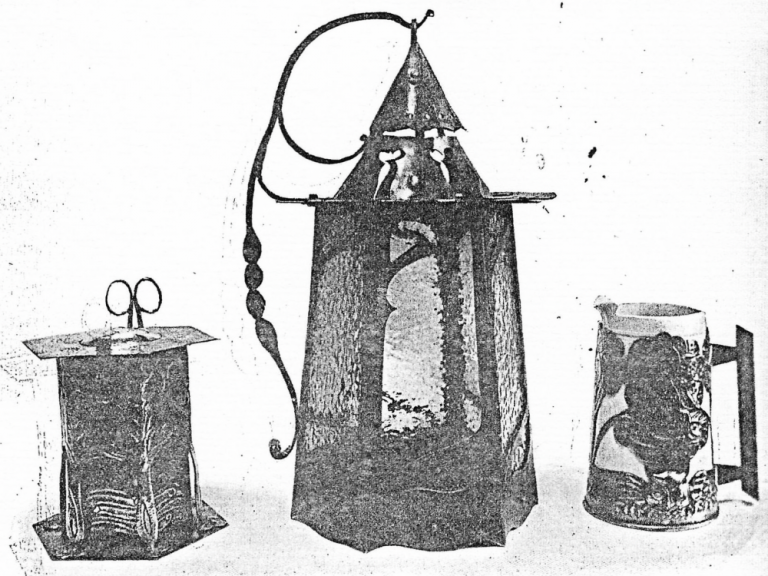
Newton School work shown in The Artist in 1901
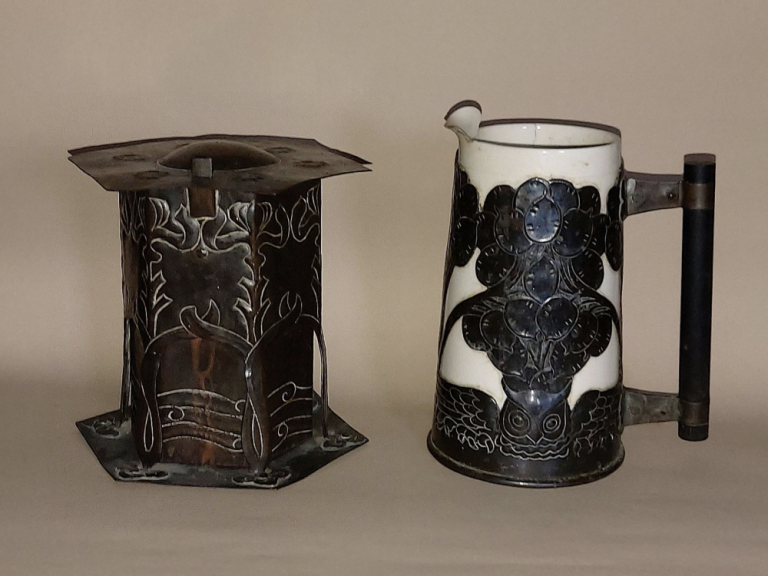
Newton School work illustrated in The Artist in 1901. Image used courtesy of Paul Reeves (www.paulreeveslondon.com)

Newton School work illustrated in The Artist in 1901. Image used courtesy of Paul Reeves (www.paulreeveslondon.com)
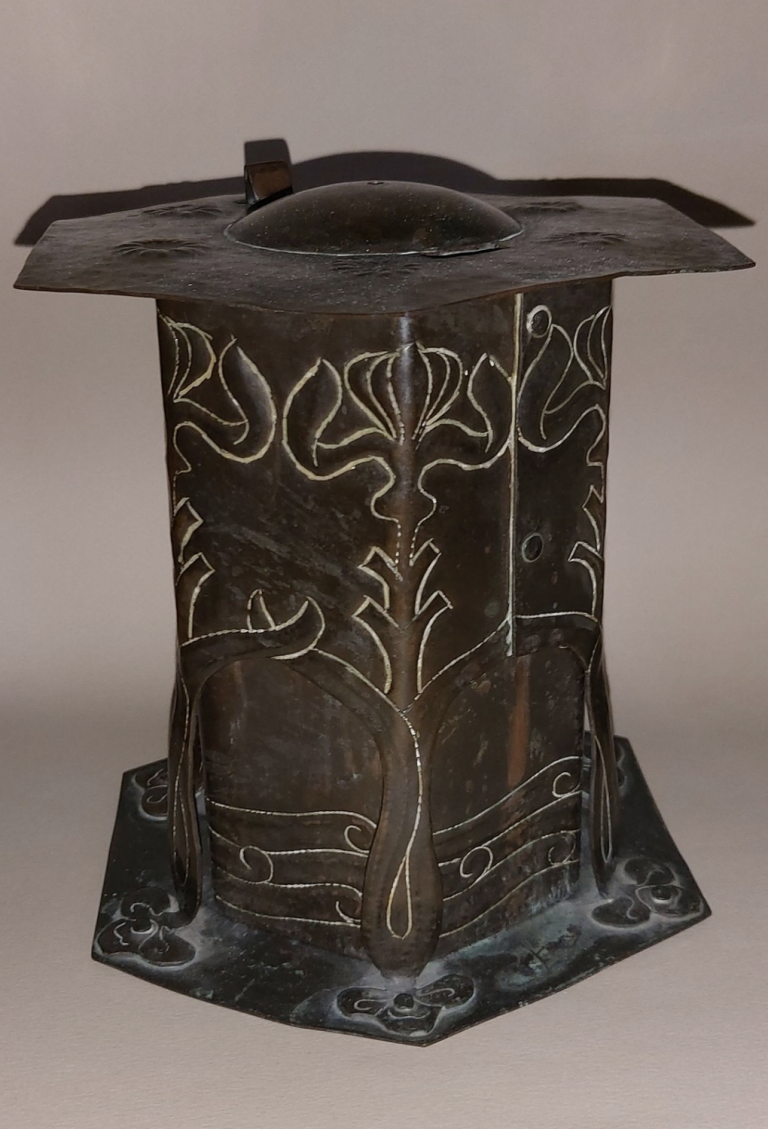
Newton School work illustrated in The Artist in 1901. Image used courtesy of Paul Reeves (www.paulreeveslondon.com)
At the 1903 Exhibition of Technical Instruction in Cambridge we get a nice description of the types of items being made by the school at the time.
“Noone could fail to admire the splendid display of repousse metal objects, in which Newton, as usual were well to the fore. Some new work was shown this year by the students in the form of specimens of enamel work and log boxes. The former comprised various articles such as cigarette boxes and hair pin trays made of beaten metal riveted with hinged lids and various colours of stone worked in by way decoration. The other goods were quaintly made boxes for wooden logs to stand beside the fireplace. Both were extremely pretty and effective18”.
Prize winners this year included George Thurlowe, Ernest Andrews, Albert Prime, Sergeant Newling, Fred Starr, James Kidman, Esau Fuller, Stanley Rogers, Cyril Rogers, Malcolm Rogers, John Day, Alex Rogers, Elijah Fuller and Albert Todd18.
From the mayors speech that year we learn that the school had earned £210 during the last year, equating to over £1 and 6 shillings per head of the villages population and that there had not been one conviction in the village for drunkenness for many years past. He went on to say that their had been a distinct improvement in the cottage homes of the workers interested in the evening classes and that there was all the right material in Newton to form a Guild in the craft of metalwork18.
During 1905 and 1906 the school exhibited at the Home Art Exhibition at Lowestoft19and at the Arts and Crafts Exhibition at the Guildhall in Cambridge20,21.
In 1907 an interesting article appeared in the Cambridge Independent Press. The altar cross mentioned in the article is most likely the one pictured previously dedicated to Ann Eliza Nash.
“Public attention has been drawn to the very commendable local industry that is carried on at the little village of Newton in Cambridgeshire, through the exhibition now being held at South Kensington by the Home Arts and Industries Association. Our industrious friends at Newton take a foremost place in the local industries of East Anglia. Their speciality is metalwork, and visitors to the exhibition express astonishment that horsemen and ploughmen, as actually is the case here, could have found the patience to execute work with such care and skill. Under the guidance of Mr. H. Hurrell, who resides at Newton, practically all the agricultural labourers in the village have spent four evenings a week learning metalwork, with pleasing financial results to them – so the report say – and with credit to their instructor. One of the pupils, a ploughman, has made an altar cross, the ornamentation of which is so perfectly worked that the villages have subscribed the purchase price, £8, in order to place it in the church in memory of a lady benefactor. A coach house belonging to Mr Hurrell has been converted into a workshop, and here everything is done, no man getting less than 3s. for his week of four evenings. So far, it is stated, substantial sums have been earned in the aggregate, and in the last few years the articles made, which include hammered pewter, have brought in £300. This is the sort of self help which deserves encouragement and support22”
The school continued to exhibit at the Arts and Crafts Exhibition in Cambridge and in 1910 the collection displayed by the school carried off five second and two third class certificates, the successful work being executed by Messrs E. Andrews, F. Starr, F. Rogers and E. Thurlow23.
In 1910 the school appeared at the Arts and Crafts Exhibition held at Ipswich and the school received special mention.
“The Newton School of Metal Work held in the village of Newton, near Cambridge, which has a population of about 156 inhabitants, sent a large variety of examples of metalwork done by the students, who are mostly youths and men that work on the land. The stall is also in the main hall. The display was arranged by Mr. H. W. Hurrell , who manages the class and who states that the work which has been fostered by the County Council and is in connection with South Kensington began in 1890. The class consists of about twenty persons and, at the exhibition of the Home Arts and Industries in London, the Queen and other members of the Royal Family made purchases from their stall. One of the best pieces of work shown at the Ipswich exhibition is a copper bowl with a brass rim riveted on, which has been hammered out from the flat. There is also a muffin dish of copper, which is very creditable, the lid fitting most perfectly. There is a copper hand lantern made to an original design by a Ploughman and several artistic toasting forks made with steel wire by an engine driver. A youth of sixteen is responsible for a neat little sweet dish in pewter.24”
In 1901, Albert Prime is listed as a Teamster on a farm25. By 1911, he is shown as a Copper worker at the Technical Night School26, which suggests that he became a full time worker and most likely teacher at the School at sometime during the decade.
The school exhibited at the Arts and Crafts Exhibition in Cambridge in 191427but their success story was then interrupted by the First World War. Over 50 men joined the colours out of a population of 20028and some of the family surnames of the workers sadly show up on the War Memorial.
After the war ended the information about the school is much harder to find. In November of 1920 a brass plaque was placed on the wall of church in Newton. It had been designed and made by the school to commemorate those who had dies during the war29.
Harold Hurrell was clearly instrumental in both the formation and the continued success of the school. He personally supervised all the work of the class, carried on all correspondence, and was responsible for the finances. He collected new ideas and designs when travelling in this country and abroad. He personally exhibited the work of the school each year at the exhibition of the Home Arts and Industries Association held in London1.
Unfortunately his good work was interrupted by his sudden death in September 1926. However the work at the school did carry on in some form or another up until around 1940.
I am pleased to have added more to the story of Harold Hurrell, the mysterious “Miss Nash” and a long list of farm labourers turned art metalworkers. I would love to hear from anyone who can add to this story in any way. Attributable pieces by the Newton School are very rare and it is a shame that there are not more examples of their designs and craftsmanship for all to see.
- Leaflet on the history of Newton village
- 1891 England Census
- East Anglia daily Times 16thFeb 1910
- Herts and Cambridge Report 18thDec 1891
- Cambridge Independent Press 2ndJun 1893
- The Studio, 1894
- Cambridge Independent Press 24thMay 1895
- Herts and Cambridge Reporter 8thMay 1896
- Cambridge Chronicle and Journal 14thMay 1897
- The Studio 1897
- The Studio 1898
- Cambridge Independent Press 8thApril 1898
- Cambridge Daily News 26thApr 1899
- Cambridge Independent Press 28thApr 1899
- Cambridge Daily News 7thApril 1900
- Cambridge Chronicle and Journal 13thApr 1900
- Cambridge Independent Press 26thApr 1901
- Cambridge independent Press 1stMay 1903
- Norwich Mercury 14thOct 1905
- Cambridge Independent Press 15thSep 1905
- Cambridge Independent Press 16thNov 1906
- Cambridge Independent Press 10thMay 1907
- Cambridge Independent Press 20thNov 1908
- East Anglia Daily Times 16thFeb 1910
- 1901 England Census
- 1911 England Census
- Cambridge Independent Press 8thMay 1914
- Cambridge Daily News 25thSep1920
- Cambridge Independent Press 19thNov 1920